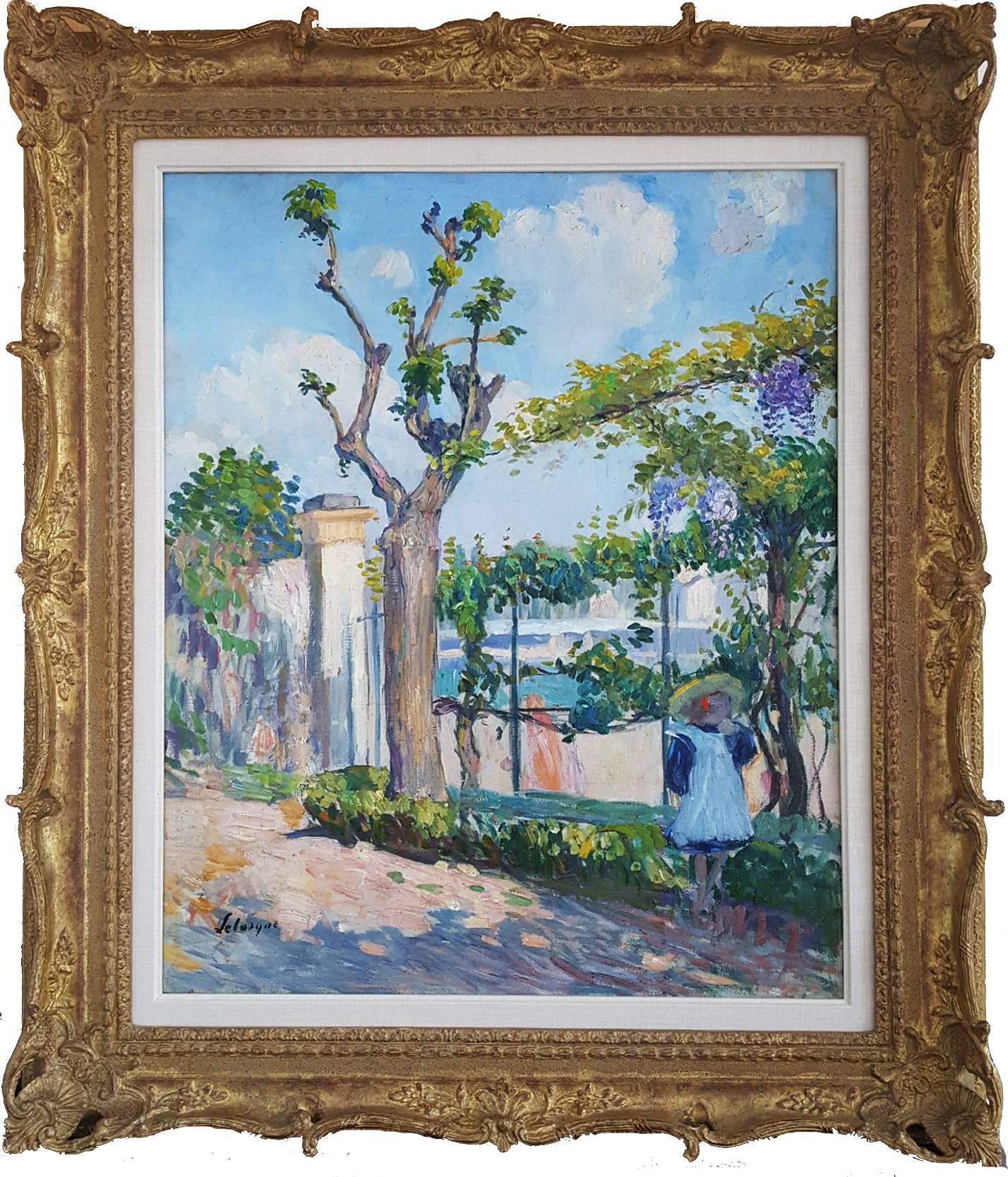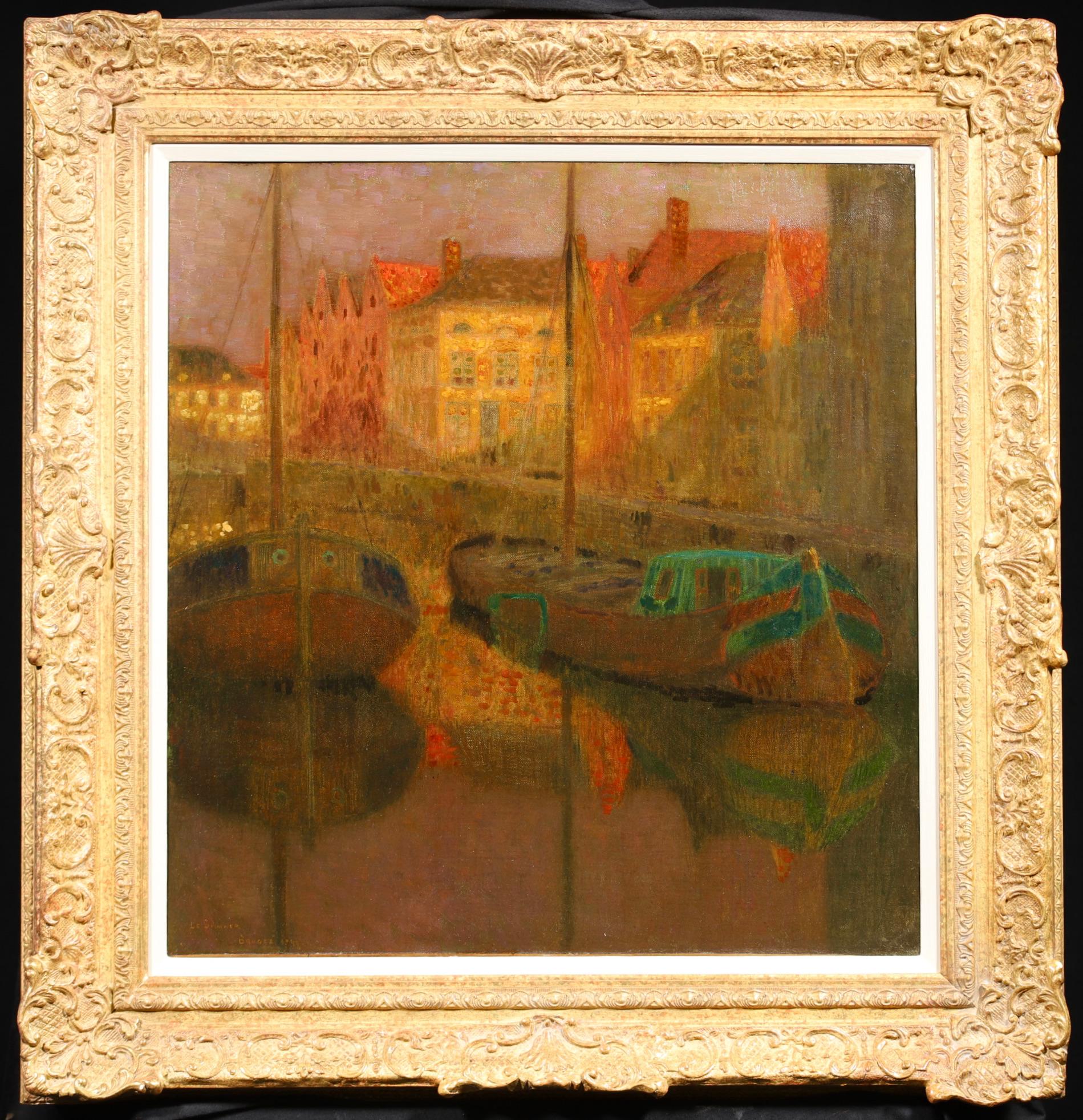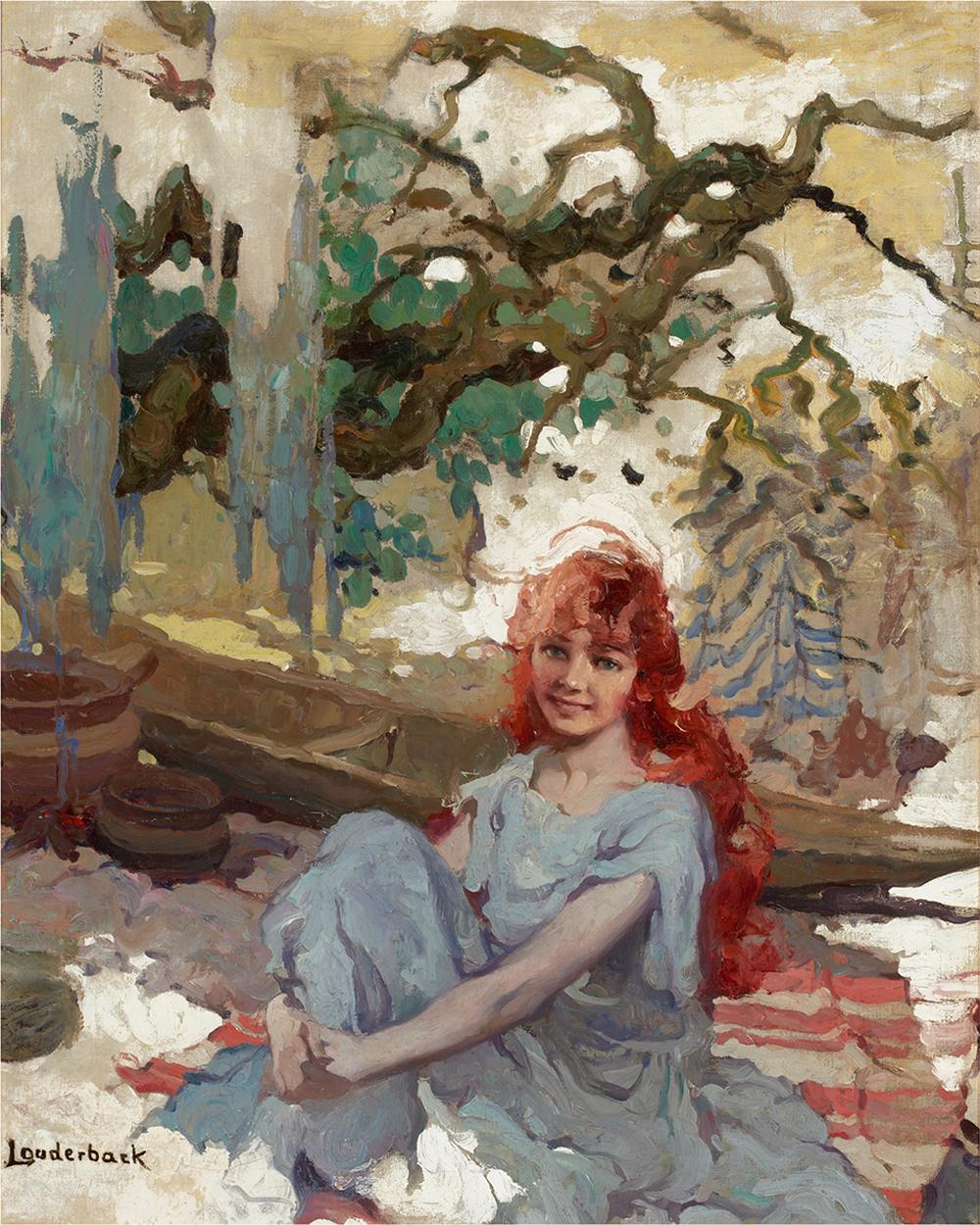Items Similar to Chemin de la Vallée, Oil on Canvas by Paulémile Pissarro
Want more images or videos?
Request additional images or videos from the seller
1 of 9
Paulémile PissarroChemin de la Vallée, Oil on Canvas by Paulémile Pissarro
About the Item
Chemin de la Vallée by Paulémile Pissarro (1884 - 1972)
Oil on canvas
46 x 61 cm (18 ¹/₈ x 24 inches)
Signed lower left, Paulémile. Pissarro-
Signed and titled on the reverse
Provenance
Stern Pissarro Gallery, London
Private collection, London
This work is accompanied by a certificate of authenticity by Lélia Pissarro and will be included in the forthcoming catalogue raisonné.
Artist's Biography
Paulémile Pissarro, Camille Pissarro’s youngest son, was born in Éragny in 1884 where he was brought up within the creatively fertile environment of his family home and, encouraged by his father, began drawing at an early age. Paulémile’s godfather was Claude Monet, who became his teacher and legal guardian after Camille’s death in 1903.
In 1905 Paulémile exhibited at the Salon des Indépendants for the first time. Although his father had supported Paulémile’s desire to be an artist, his mother was eager for him to learn a more practical trade. Therefore in 1908 he put aside his artistic pursuits to work as an automobile mechanic and test-driver, then later as a lace and textile designer, allowing him only a limited time to paint. Paulémile only fully dedicated himself to painting following a letter from his brother Lucien in London, who wrote to invite him to take part in an exhibition held in London. Subsequent to the successful sale of a number of watercolours he had sent over, the young artist became inspired to leave the textile factory and pursue a career in art.
By the 1920s Paulémile had become an established Post-Impressionist artist in his own right, spending the summer months escaping from Paris on painting trips with fellow artists Kees Van Dongen, Raoul Dufy, Maurice de Vlaminck and André Dunoyer de Segonzac. In 1922 Paulémile purchased a house in Lyons-la-Forêt, a small village within the region of his hometown of Éragny and Giverny, where he moved in with his first wife Berthe Bennaiche. During this time, he developed a form of Cubism inspired by Paul Cézanne whom he dearly admired, creating some wonderful paintings of the river Eure and its surrounding villages. There he formed a close friendship with his neighbour, the famous Art Deco designer Émile-Jacques Ruhlmann, who designed a stunning Art Deco studio for Paulémile adjacent to his house.
In 1930 he visited and fell in love with the Swiss Normandy area in the Calvados region, in particular the River Orne which runs through the valley adjacent to the villages of Clécy and St. Remy. The combination of rolling hills, bold meadows and the calm river weaving its way through the landscape offered Paulémile a new burst of inspiration. With his second wife Yvonne Beaupel, Paulémile eventually moved to Clécy in 1935, where he would remain for the rest of his life. Of their three children, both H. Claude and Yvon also became artists.
With his house backing on to the river Orne, Paulémile developed a new way of working using a boat as a floating studio, where he spent countless days painting the calm waters from between the riverbanks. Here the influence of his godfather Claude Monet became apparent, particularly in Paulémile’s depiction of water, which was revolutionised by the Impressionist icon. He also applied Monet’s lessons in horticulture to the creation of an abundant garden, offering him many more motifs for his new paintings. Alongside these river landscapes, he also painted the neighbouring hay fields, various snow scenes, some interiors and still lives. The most ambitious work in his oeuvre was a fresco painted on all four walls of his own dining room, depicting the adjacent river in which he includes family members, neighbours and friends.
In 1967 Paulémile had his first one-man show in the United States at Wally Findlay Galleries in New York. This led to widespread recognition and a degree of professional success that few Pissarro artists knew during their lifetime. Since his death in 1972, Paulémile remains one of the best known of Camille’s sons.
- Creator:Paulémile Pissarro (1884 - 1972, French)
- Dimensions:Height: 18.12 in (46 cm)Width: 24.02 in (61 cm)
- Medium:
- Movement & Style:
- Period:
- Condition:
- Gallery Location:London, GB
- Reference Number:1stDibs: LU261212344872
About the Seller
5.0
Recognized Seller
These prestigious sellers are industry leaders and represent the highest echelon for item quality and design.
Platinum Seller
These expertly vetted sellers are 1stDibs' most experienced sellers and are rated highest by our customers.
Established in 1964
1stDibs seller since 2015
95 sales on 1stDibs
Typical response time: 4 hours
Associations
Society Of London Art Dealers
- ShippingRetrieving quote...Ships From: London, United Kingdom
- Return PolicyA return for this item may be initiated within 7 days of delivery.
More From This SellerView All
- Bords du Loing by Alfred Sisley - Oil, landscape paintingBy Alfred SisleyLocated in London, GB*THIS PRICE INCLUDES 5% IMPORT DUTY APPLICABLE IF THE WORK REMAINS IN THE UK ONLY. Bords du Loing by Alfred Sisley (1839-1899) Oil on canvas 46.1 x 55.7 cm (18¹/₈ x 21⁷/₈ inches) S...Category
1890s Post-Impressionist Landscape Paintings
MaterialsCanvas, Oil
- L'Orne au Pont de Vey by H. Claude Pissarro - Post-Impressionist styleBy Hughes Claude PissarroLocated in London, GB*UK BUYERS WILL PAY AN ADDITIONAL 20% VAT ON TOP OF THE ABOVE PRICE L'Orne au Pont de Vey by H. Claude Pissarro (b. 1935) Oil on canvas 38 x 46 cm (15 x 18 ¹/₈ inches) Signed lower ...Category
21st Century and Contemporary Post-Impressionist Figurative Paintings
MaterialsCanvas, Oil
- La Rivière by PAULÉMILE PISSARRO - Post Impressionist Landscape Painting, RiverBy Paul Emile PissarroLocated in London, GB*UK BUYERS WILL PAY AN ADDITIONAL 20% VAT ON TOP OF THE ABOVE PRICE La Rivière (The River) by PAULÉMILE PISSARRO (1884-1972) Oil on canvas 92 x 73 cm (36 1⁄4 x 28 3⁄4 inches) Signed...Category
1930s Post-Impressionist Landscape Paintings
MaterialsOil, Canvas
- Paysage d'Hiver by Paulémile Pissarro - River scene, oil paintingBy Paul Emile PissarroLocated in London, GB*UK BUYERS WILL PAY AN ADDITIONAL 20% VAT ON TOP OF THE ABOVE PRICE Paysage d'Hiver by Paulémile Pissarro (1884-1972) Oil on canvas 54 x 65 cm (21 ¹/₄ x 25 ⁵/₈ inches) Signed lower ...Category
1950s Post-Impressionist Landscape Paintings
MaterialsOil, Canvas
- La Mare et les Vieux Saules by Paulémile Pissarro, Post-Impressionist riverscapeBy Paul Emile PissarroLocated in London, GB*UK BUYERS WILL PAY AN ADDITIONAL 5% IMPORT DUTY ON TOP OF THE ABOVE PRICE La Mare et les Vieux Saules by Paulémile Pissarro (1884-1972) Oil on canvas 46 x 55 cm (18 ¹/₈ x 21 ⁵/₈ i...Category
1930s Post-Impressionist Landscape Paintings
MaterialsOil, Canvas
- Neige à Grandcamp, oil on canvas by H. Claude Pissarro - Snow sceneLocated in London, GB*UK BUYERS WILL PAY AN ADDITIONAL 20% VAT ON TOP OF THE ABOVE PRICE Neige à Grandcamp by H. Claude Pissarro (b. 1935) Oil on canvas 46 x 55 cm (18 ¹/₈ x 21 ⁵/₈ inches) Signed lower ...Category
21st Century and Contemporary Post-Impressionist Figurative Paintings
MaterialsOil, Canvas
You May Also Like
- Le Jardin de Lagny - Garden with young girl Post-impressionistBy Henri LebasqueLocated in Miami, FLLe Jardin de Lagny Provenance: Arthur Tooth, London Radon Gallery, NY This beautiful evocation of a lyrical French landscape is a fine example of of Po...Category
Early 1900s Post-Impressionist Landscape Paintings
MaterialsOil, Canvas
- Barques de Peche - Post Impressionist Landscape Oil by Henri Le SidanerBy Henri Le SidanerLocated in Marlow, BuckinghamshireSigned post impressionist landscape oil on canvas by French painter Henri Le Sidaner. This stunning piece depicts two fishing boats moored in a fishing village at sunset. The last l...Category
1890s Post-Impressionist Landscape Paintings
MaterialsOil, Canvas
- Girl with canoe painted in Arts and Crafts styleBy Walt LouderbackLocated in Miami, FLSigned lower left. Most likely for Saturday Evening Post or Colliers. Louderback is a painter/illustrator of the Golden Age of Illustration...Category
1920s Post-Impressionist Figurative Paintings
MaterialsCanvas, Oil
- Haystack with Resting FiguresBy John Maclauchlan MilneLocated in Hillsborough, NCScottish artist John Maclauchlan Milne, RSA, (1885-1957) is a contemporary of Scottish Colourists Peploe, Fergusson, Cadell and Hunter. Like the...Category
1920s Post-Impressionist Landscape Paintings
MaterialsCanvas, Oil
- Henri-André Martin, Les Baux de Provence, Oil on Canvas, 1961By Henri-André MartinLocated in Saint Amans des cots, FROil on canvas by Henri-André Martin (1918-2004), France, ca.1980s. Les Baux de Provence. With frame: 71x98 cm - 28x38.6 inches. Without frame: 65x92cm - 25.6x36.2 inches. 30P format. Signed lower right "Henri A Martin" (see photo). Located and dated 1961 on the back (see photo). Can be matched to make a pair with another painting by Henri-André Martin that we offer on 1stdibs whose title is "Henri-André Martin Olive Tree Field in the Alpilles, Provence, Oil on Canvas". Born in Lyon in 1918, the child and the adolescent Henri-André Martin spent his youth in Saint-Étienne, his father, Edme Martin, first installed as a practicing doctor in Lyon, having been appointed doctor of the anti-tuberculosis dispensaries of the Loire. During his first years of studying medicine in Lyon, he nevertheless enrolled in the Beaux-Arts. Appointed hospital intern upon his return from captivity in 1942, he ended his medical career as director of the otolaryngology university clinic at Édouard-Herriot hospital. But painting was his passion. Painting was for Henri-André Martin the way of expressing his feelings. By nature very reserved and of an extreme modesty that many took for coldness, it was what allowed him to express his strong artistic sensitivity and, his pictorial periods are as many reflects of his anxieties, of his hopes, of his joys. At every period of his life, wherever he goes and whenever he has a moment, he paints gouaches, often of small size, but sometimes of larger size. He also paints beaches that have been compared to those of Boudin. Their invoice shows, however, that this figure is only appearance and that in fact, these beaches made of water, sky and sand, readily dispense with the motif, the work of the material seeming to have more importance. as the subject. Despite the fact that until the 1970s he painted "on the ground", his canvases remain far removed from the anecdote. Often harsh like the landscapes of Provence, the Parisian walls which express concern, or the railways, the switch tracks which suggest, in ocher and black, all the embarrassment of choice. We find the same nostalgic gravity in the canvases of the carcasses of boats which, as his friend Louis Pons later wrote, "seem to die of immobility" or in the canvases of Venice, or the landscapes of Eygalières. In the following years, his painting became simpler, more synthetic, such as these landscapes with tortured almond trees, black and gnarled olive trees, plane trees standing out against the ocher sky of the dawn of Provence, in winter. These are also the canvases of Hamburg in the dough becomes heavier, the colors darken, marking all the gravity of the port landscapes. Workshop work gradually takes precedence over motif painting. The pivotal period coincides with that of his work on the olive tree, during which he leads the realization of the "Trunks", a collection of six lithographic plates, of the book L'olivier comprising many lithographs and serigraphs, but also texts. poetic and numerous paintings. He then became passionate about everything related to the olive tree (literature, painting, traditions, history), but also to the tree itself, its thousand-year-old history, its poetry, its symbols, but also its culture, its size. oil production...Category
1960s Post-Impressionist Figurative Paintings
MaterialsCanvas, Oil
- Notre-Dame de Paris, Oil on Canvas by Henri André MartinLocated in Saint Amans des cots, FROil on canvas by Henri-André Martin (1918-2004), France, ca.1960. Notre-Dame de Paris. With frame: 79.3x 60.3 cm - 31.2x23.7 inches. Without frame: 54x 73 cm - 21.3x28.7 inches. 20P format. Signed lower left "Henri A. Martin" (see photo). Born in Lyon in 1918, the child and the adolescent Henri-André Martin spent his youth in Saint-Étienne, his father, Edme Martin, first installed as a practicing doctor in Lyon, having been appointed doctor of the anti-tuberculosis dispensaries of the Loire. During his first years of studying medicine in Lyon, he nevertheless enrolled in the Beaux-Arts. Appointed hospital intern upon his return from captivity in 1942, he ended his medical career as director of the otolaryngology university clinic at Édouard-Herriot hospital. But painting was his passion. Painting was for Henri-André Martin the way of expressing his feelings. By nature very reserved and of an extreme modesty that many took for coldness, it was what allowed him to express his strong artistic sensitivity and, his pictorial periods are as many reflects of his anxieties, of his hopes, of his joys. At every period of his life, wherever he goes and whenever he has a moment, he paints gouaches, often of small size, but sometimes of larger size. He also paints beaches that have been compared to those of Boudin. Their invoice shows, however, that this figure is only appearance and that in fact, these beaches made of water, sky and sand, readily dispense with the motif, the work of the material seeming to have more importance. as the subject. Despite the fact that until the 1970s he painted "on the ground", his canvases remain far removed from the anecdote. Often harsh like the landscapes of Provence, the Parisian walls which express concern, or the railways, the switch tracks which suggest, in ocher and black, all the embarrassment of choice. We find the same nostalgic gravity in the canvases of the carcasses of boats which, as his friend Louis Pons later wrote, "seem to die of immobility" or in the canvases of Venice, or the landscapes of Eygalières. In the following years, his painting became simpler, more synthetic, such as these landscapes with tortured almond trees, black and gnarled olive trees, plane trees standing out against the ocher sky of the dawn of Provence, in winter. These are also the canvases of Hamburg in the dough becomes heavier, the colors darken, marking all the gravity of the port landscapes. Workshop work gradually takes precedence over motif painting. The pivotal period coincides with that of his work on the olive tree, during which he leads the realization of the "Trunks", a collection of six lithographic plates, of the book L'olivier comprising many lithographs and serigraphs, but also texts. poetic and numerous paintings. He then became passionate about everything related to the olive tree (literature, painting, traditions, history), but also to the tree itself, its thousand-year-old history, its poetry, its symbols, but also its culture, its size. oil production...Category
1960s Post-Impressionist Landscape Paintings
MaterialsCanvas, Oil
Recently Viewed
View AllMore Ways To Browse
Eucalyptus Screen
Francesco Tironi
Francois Charles Cachoud
Frank Peyraud
Franklin Dullin Briscoe
Fred Dalkey
Frederick Colbus On Sale
George Lafayette Clough
George Renouard On Sale
George Sanders Bickerstaff On Sale
Glynn Williams
Gottardo Segantini
Gustaf Rydberg
Half Dome Yosemite Watercolor
Harry Wagoner
Henry Schnakenberg
Higgins Boat
Hillcountry Landscape




